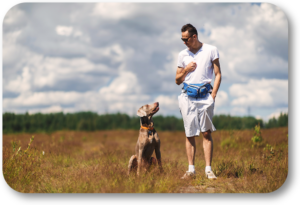Last week Robin and I were in Dacula working with a new Home Dog Training client and his young Irish Setter. After the training, we stopped off for a quick, late lunch at one of the local diners. As we were finishing our meal and preparing to depart, one of the other restaurant diners came up to us with a question. I was wearing my “Home Dog Training” golf shirt and Robin had on her “Home Dog Training” sweatshirt, so it was clear that we were dog trainers. He first apologized for the interruption and hoped that he was not being a hassle. We assured him that we get questions from dog owners all the time and were always more than willing to offer any assistance.

Our inquiring dog owner said that he had been having difficulties with his puppy over the last several months. At this point, he said he didn’t know what else he could do. His problem was that he just couldn’t get his puppy’s attention. He had talked to friends who had dogs for many years and read every article he could find on the internet. Nothing seemed to fix the problem. His errant puppy just would not listen to him.
He commented that there were just so many different viewpoints on the subject. One “expert” often suggested the exact opposite from another “expert”. Bottom line, nothing was working, he was completely confused, and was at his wit’s end. Did we have any suggestions?
We told him that his problem was not unique among most dog owners. It is often difficult to get your dog to provide you with calm and respectful focus. We confided that one of the most common issues our thousands of clients originally faced was “focus and attention”. The moment we were able to instruct our clients on how to resolve this problem, they were able to effortlessly teach their dogs to be great companions. As with many things, there are various training methods that have been used by different trainers to get a dog’s focus and attention.
We went on to tell him that we are canine behavioral trainers. We focus on how the dog naturally responds to the world around him based on positive and negative distractions. A lot of trainers use positive only reward systems. Other dog trainers only use physical (negative) methods.
Although all dog trainers don’t see “eye-to-eye” on training methodology, we all concur that dogs and people communicate in slightly different ways. First of all, your dog isn’t a cartoon character similar to Astro or Scooby-Doo. Instead of verbalizing (like we do), our dogs mostly use their body language to talk. If you have more than one dog, observe them and you will see how they use their body language. You may notice one dog jumping on another dog. One dog may crouch down low or even lie on his back. You might observe one dog with his tail straight up in the air or pointed down at the ground. All these body positions help one dog communicate to the other dog.
The excellent news is that we can utilize this exact method when communicating to our dogs. You should be aware that this may not be the only thing you do when communicating with your dog. Body language is your initial communication tool when interacting with your dog. Although it will often be the only form of communication you may need, sometimes you may need to include additional, enhanced techniques. In all cases, body language is a technique that you must always use to successfully communicate with your dog. We then gave our “co-diner” some suggestions on proper communication and “canine gain-of-focus”:
- Remain calm and still when communicating with your dog. Your dog will never respond if you are providing a “picture image” of being nuts. Our problem is that we often become mad when our dog has chewed up the TV remote control or absconded with our sandwich that was sitting on the breakfast room table. We scream at them and wave our arms. This is our natural reaction when we get mad. The problem is that we are trying to communicate our displeasure to our dog. Waving our hands and yelling like a crazy person is not communicating “I am your leader, focus on me, and obey my wishes” to our dog. Our dog will positively respond when we are calm and consistent. That will communicate “See me, respect me, obey me” to him.
- Become tall and face your dog when you are about to correct. To our dog, height is dominance and dominance is leadership. This is why they jump on us when they want something. They are telling us “See me. I’m in charge and you must obey me”. We show leadership to our dog by standing up. It isn’t about your actual height. You may be 6’ 7”, 5’ 9”, or only 5’ 1”. It matters that you are as “tall as you can be”. If you are only 5’ 1” and standing erect, you are “tall” in your dog’s eyes”. In other words, don’t slouch.
No matter if you use our canine behavior training method, the positive only training method, or a more physical method, your dog must provide you with respectful and calm focus. This clearly indicates that he sees you as the boss and his caregiver. Give these two actions (stay calm and stand up) a try the next time you are working with your dog. We are sure you will receive great results.
Please call or text us at (770) 718-7704 if you need any dog training help. You can also email us at [email protected]. We are blessed to have been your local dog training experts for over eighteen years. We have trained over 6,000 wonderful dogs and excellent families and are ready to help you.

Follow Us!